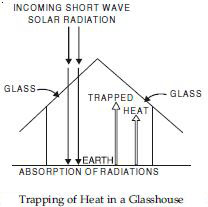Question 1:
Which one of the following is suitable for Koeppen's ‘‘A’’ type of climate?
- High rainfall in all the months
- Mean monthly temperature of the coldest month more than freezing point
- Mean monthly temperature of all the months more than 18° C
- Average temperature for all the months below 10° C.
Answer:
(c). Mean monthly temperature of all the months more than 18° C.
Question 2:
Koeppen's system of classification of climates can be termed as:
- Applied
- Systematic
- Genetic
- Empirical
Answer:
(d). Empirical
Question 3:
Most of the Indian Peninsula will be grouped according to Koeppen's system under:
- ‘‘Af’’
- ‘‘BSh’’
- ‘‘Cfb’’
- ‘‘Am’’
Answer:
(c). ‘‘Am’’
Question 4:
Which one of the following years is supposed to have recorded the warmest temperature the world over?
- 1990
- 1998
- 1885
- 1950
Answer:
(b). 1998
Question 5:
Which one of the following groups of four climates represents humid conditions?
- A – B – C – E
- A – C – D – E
- B – C – D – E
- A – C – D – F
Answer:
(d). A – C – D – F
Question 6:
Which two climatic variables are used by Koeppen for classification of the climate?
Answer:
He used mean annual temperature and mean monthly rainfall data.
Question 7:
How is the ‘genetic’ system of classification different from the ‘empirical’ one?
Answer:
Empirical classification is based on observed data of temperature and precipitation. Genetic classification is based on climate according to their causes.
Question 8:
Which types of climates have very low range of temperature?
Answer:
(a) Tropical humid climate.
(b) Marine west coast climate.
Question 9:
What type of climatic conditions would prevail if the sun spots increase?
Answer:
The climate will be cool and humid.
Question 10:
Make a comparison of climatic condition between the ‘A’ and ‘B’ type of climates?
Answer:
‘A’ type is tropical humid climate. It is found within tropics. There is low range of temperature. Temperature is uniformly high (above 30°C). ‘B’ type of climate is dry with low rainfall. It is found in 15°—60° latitudes. The rainfall is low due to descending winds. The rainfall is low in interiors of continent. It is semi-desert type.
Question 11:
What type of vegetation would you find in the ‘C’ and ‘A’ type of climate?
Answer:
In ‘A’ type tropical evergreen forests are found. Deciduous forests are found in monsoon area. In ‘C’ type of climate, temperate forests are found. Trees with long roots and thick leaves are found.
Question 11:
What do you understand by term ‘Greenhouse gases’? Make a list of greenhouse gases.
Answer:
Greenhouse Effect
This concept of heating the atmosphere indirectly from the earth’s surface is called greenhouse effect or commonly known as atmospheric effect. Obviously the effect of atmosphere is analogous to that of a glasspane, which lets through most of incoming short wave solar energy but greatly retards the outgoing long-wave earth radiation. Thus maintaining surface temperatures considerable higher than they otherwise would be. You can build an instantaneous greenhouse.
Park your car in the sun for two hours with the windows closed. Now, observe the interior temperature. It will be more than outside temperature. Growing tomatoes in winter can be accomplished by capitalising on transparency of glass roof in greenhouse to short wave.

The Greenhouse gases are :
(i) Carbon dioxide (ii) Chlorofloro carbon
(iii) Methane (iv) Ozone.
